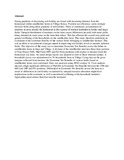Dynamics Of Urban Land Space Contestation And Their Implications On Utilization Of Public Green Spaces: A Case Of Michuki Memorial Park, Nairobi City County
Public urban green spaces are useful natural assets that are globally mainstreamed into practice as one of the nature-based solutions to counter the urban areas challenges such as climate change. Using Michuki Memorial Park as a case study, the study sought to assess dynamics of urban land space contestation and their implications on utilization of public green spaces.









